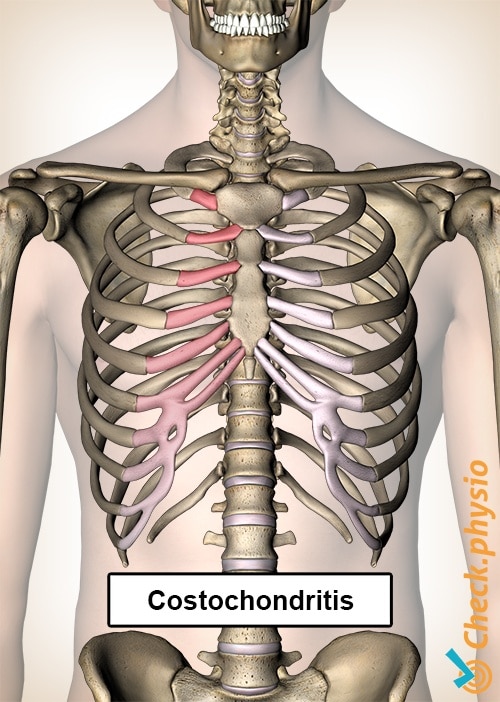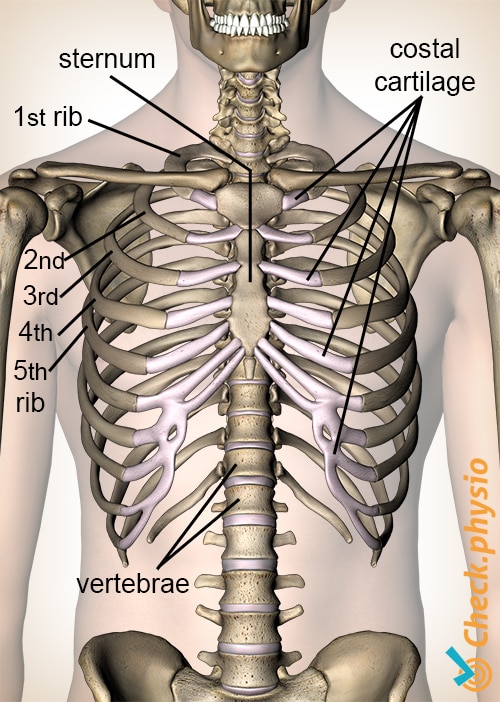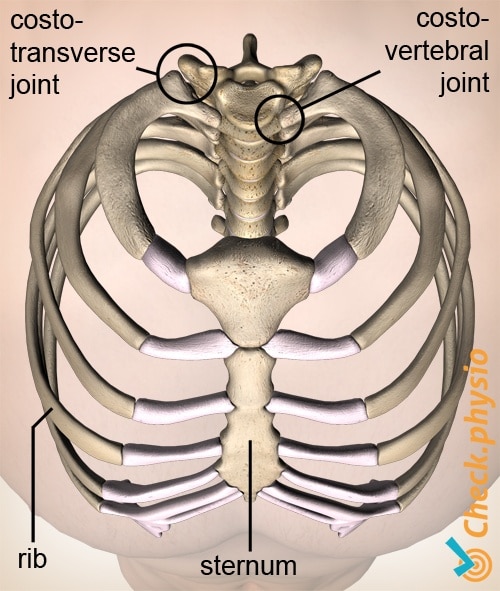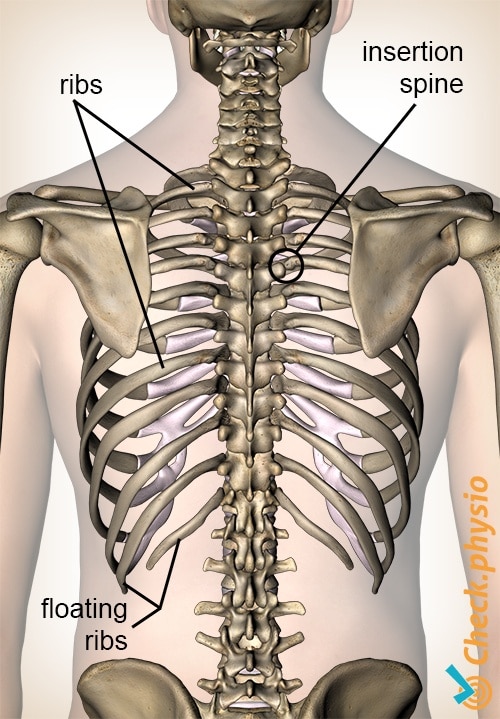Costochondritis
Chest wall pain / inflammation of the rib cartilage / costosternal syndrome / costosternal chondrodynia
Costochondritis is a painful inflammation of the cartilage of the ribs. This cartilage is located along the front of the chest where the ribs connect to the sternum, but also along the back, where the ribs attach to the spinal column.

Costochondritis is a relatively unknown rheumatic condition. As the condition often causes pain on the chest, it is always important to rule out cardiac problems before making the diagnosis.
Description of the condition
The chest (rib cage) is formed by the ribs, the breastbone and a number of vertebrae. Along the front, the ribs are connected to the breastbone by cartilage structures. These cartilage connections are referred to in medical terms as 'costal cartilage'. If this cartilage becomes inflamed, this is referred to as costochondritis. Inflammation of the 'costal cartilage ' causes annoying pain on the chest.
Along the back, the ribs are connected to the vertebrae of the spinal column via small joints (also containing a layer of cartilage). These joints are called the 'costovertebral' and the 'costotransverse' joints. Again, if the cartilage becomes inflamed, this is referred to as costochondritis. Costochondritis along the back can cause back pain in the upper back.
Tietze's Syndrome
Costochondritis is very similar to Tietze's syndrome. However, there are a few important differences. When the cartilage of the ribs along the front of the body is inflamed and is accompanied by swelling, this is referred to as Tietze's syndrome. If there is no swelling, or if the cartilage along the back side of the ribs is inflamed, this is referred to as costochondritis. Unfortunately, both terms are often used interchangeably in the literature.
Cause and origin
The cause is currently unknown. However, we suspect that the following factors play a role in the development of the conditions:
- Physical exertion.
- Incorrect posture (for example, a stooped posture with rounded back and shoulders protruding forwards).
- Over-loading or trauma (for example, falling or bumping the chest).
- Pregnancy.
- Respiratory tract infection.
- Emotional exertion/tension.
- Stress.
- Repetitive movements that expand the chest, causing pressure or tractive force on the ribs (for example, deep breaths, lots of coughing or repeated clearing of the throat).
People with a family history of rheumatic conditions have an increased risk of developing the condition. Postural abnormalities, limited muscle strength, fear of movement and a low exercise tolerance are also linked to an increased risk of developing costochondritis.
Signs & symptoms
Several cartilage connections are usually affected in the case of costochondritis. In many cases it affects the second to fifth rib. It is worth noting that generally only one side is affected.
- Pain on the chest and/or pain in the upper back at the level of the cartilage connections.
- The pain is often sharp and comes in waves.
- Pressing on the inflamed cartilage makes the pain worse.
- Coughing, sneezing or deep inhalation is extra painful.
- The pain can radiate to the ribs, the arm, the shoulder or the abdomen.
- Movements of the upper body cause extra pressure or tractive force on the cartilage connections. This can result in extra pain.
- As the entire rib cage moves along with the various arm movements, certain movements of the arm can provoke the symptoms.
Diagnosis
The diagnosis is made according to the physical examination and the patient's story.
Treatment
Unfortunately there is no real treatment. Patients are often prescribed analgesics to relieve the pain, or anti-inflammatories. Sometimes injections are administered at the site of the inflammation.
In some cases the symptoms disappear without treatment within several days or weeks. However, the condition can become chronic, causing problems for months or years. Sometimes the symptoms never go away completely.
Physiotherapy can be used to work on improved posture, thereby reducing the pressure on the painful cartilage connections. Therapy can also consist of the stretching of the pectoralis major muscle and strengthening of the rhomboid muscles located between the shoulder blades. If necessary, relaxation exercises and breathing exercises will be provided.
Exercises
Follow the exercise programme here exercises for costochondritis or make an appointment with the physiotherapist.
You can check your symptoms using the online physiotherapy check or make an appointment with a physiotherapy practice in your area.



References
Albarran, J.W. & Tagney, J. (2007). Chest Pain. Advanced assessment and management skills. Blackwell Publishing.
Haga, P., Biesen-’t Riet, J. van der & Broekema, A. (2008). Protocol syndroom van Tietze en costochondritis. Oefentherapeuten Mensendieck.
Lawless, C.E. (2011). Sports cardiology essentials: Evaluation, management and case studies. Springer: New York, Dordrecht, Heidelberg, London.
Proulx, A.M. & Zyrd, T.W. (2009). Costochondritis: Diagnosis and treatment. Am Fam Physician. 2009 Sep 15;80(6):617-20.





